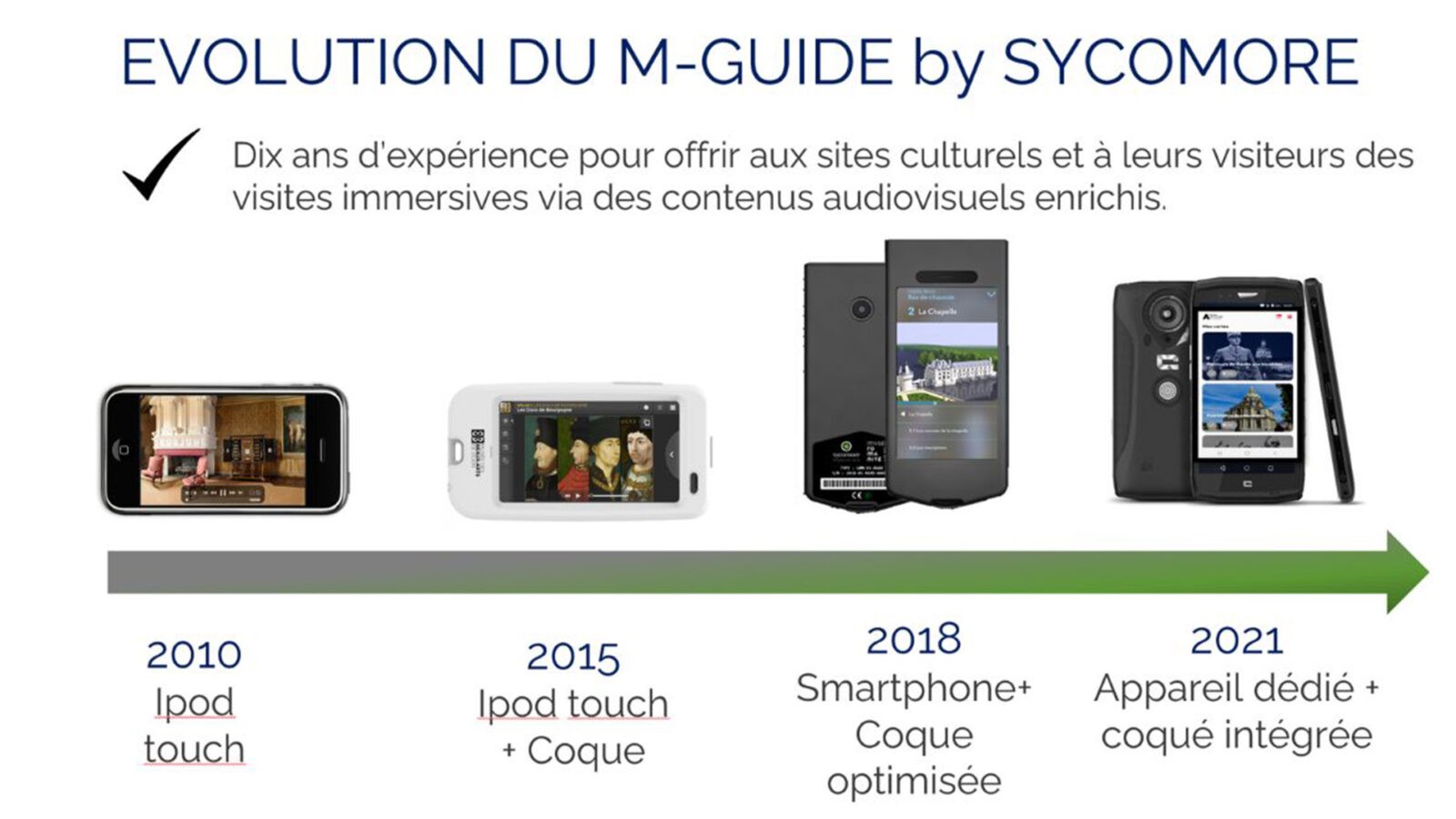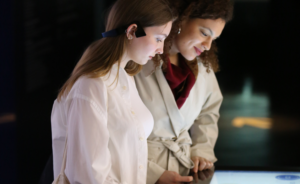Blog

MGuide innovation: The evolution of Multimedia Guides over the years
Introduction
The evolution of multimedia guides over the years has profoundly changed the visitor experience in museums and cultural sites. If software advances have greatly contributed to the improvement of visits, the manufacturing processes of multimedia guides have also undergone major transformations in terms of hardware, allowing more durable, ergonomic use and adapted to the needs of users. This article focuses on the evolution of physical devices that have marked recent decades.

The First Devices: The Birth of the Multimedia Guide
In 2004, the Château de Chenonceau called on Sycomore to develop an autonomous visit solution. This partnership marks one of the first turning points in the history of multimedia devices with the introduction of an iPod as an interactive multimedia guide. This revolutionary device at the time allowed visitors to listen to audio-guided commentaries without following a predetermined route. Although the iPod technology was relatively simple, it laid the foundation for what would later become the interactive multimedia guide and MGuide technology.
The Introduction of the iPod Touch: A Hardware Evolution
A few years after the introduction of the iPod, Sycomore innovated again by integrating the iPod Touch into the tour routes. This new material brought several notable material advantages:
- A larger touch screen, allowing better interaction.
- Increased storage capacity, making it easier to integrate richer video and audio content.
- Better ergonomics, with more intuitive handling for users of all ages.
This transition to a more advanced device has enabled richer and more immersive experiences, while improving sustainability and audience interaction. This step marks a step forward in the production of ever more efficient multimedia guides.
The Transition to the Consumer Smartphone with Protective Shell: Robustness and Durability
In 2015, Sycomore took a new step by launching a multimedia device based on Smartphone technology, specially designed for busy cultural sites. This multimedia guide for museums introduces an important hardware innovation: a robust protective shell. This hull had several objectives:
- Protect the device against drops, scratches and wear and tear from intensive use.
- Make the device accessible to all audiences, including children, thanks to a secure grip.
- Increase the lifespan of equipment, minimizing damage caused by daily handling by visitors.
This version proved particularly suitable for environments where the multimedia guide had to be handled by thousands of visitors every day. This model was used for the first time in partnership with the Louvre Lens, confirming the ability of these devices to meet the needs of major tourist sites.
Hull Optimization in 2018: The Embedded Version
In 2018, Sycamore further perfected the hardware design of its multimedia guide with an optimized version of the protective shell. This new design, called an “on-board shell”, integrated directly into the device, offered even more solid protection without compromising ergonomics. The Château de Chenonceau, always a pioneer in technological innovation, was the first site to adopt this new generation of devices.
This improved version marked a turning point in the evolution of multimedia guides, with hardware features better suited to the challenges of cultural sites, including:
- Better integration of components in the hull, to avoid any damage in the event of impact.
- A more comfortable grip, facilitating use by a wide range of audiences.
- Increased resistance, making the devices virtually indestructible in demanding environments.
New Generation Devices: Solidity and Integrated Design
Since 2021, multimedia guide devices have taken another step forward by abandoning external protective shells. The new models are designed to be naturally rugged, with a shell integrated directly into the design of the device. These devices look more like smartphones, but are tailored to the specific needs of museums and cultural sites.
Among the hardware characteristics of the new devices, we find:
- Larger screens, providing an enhanced visual experience for videos and interactive maps.
- Careful ergonomics, with intuitive and comfortable handling.
- Reinforced resistance, with materials certified for their high resistance to falls and wear.
- Long-lasting batteries, allowing continuous use throughout the day without the need for frequent recharging.
These more elegant and durable devices meet the demands of modern visitors while providing greater sustainability for cultural institutions. Within Sycamore, this innovation is called MGuide technology. The objective has always been to innovate to create multimedia guides perfectly adapted to the needs of museums and cultural sites.
Software Advances: Interactive Maps and Enriched Content
If the hardware of the devices has evolved to become more solid and efficient, software advances have also played a crucial role in improving the visitor experience. The new multimedia guides include enhanced features such as:
- Interactive maps: Thanks to high-definition touch screens, visitors can now explore geolocated maps, inside and outside the sites, to better find their way.
- Geolocation: The devices are equipped with geolocation systems that allow visitors to track their location in real time. Institutions can also use this data to optimize visitor flows.
- Immersive content: New devices can display videos, archive images, interviews, and augmented and virtual reality experiences. This content enriches the journey and changes visitors’ views of the works and monuments.
- Integrated e-commerce: The devices can also promote ancillary museum services, such as shops, restaurants, and surrounding attractions, providing a more complete and personalized experience.
These software innovations, coupled with hardware advances, now make it possible to create visit experiences that are more immersive, interactive and accessible to all audiences.

These software innovations, combined with hardware advances, now make it possible to create visit experiences that are more immersive, interactive and accessible to all audiences. The evolution of multimedia guides over the years has transformed cultural visits into interactive and enriching experiences. From the first iPods to the latest generation devices, designed to be robust and ergonomic, the process of manufacturing multimedia guides has continued to evolve and improve to meet the expectations of visitors and the requirements of cultural institutions. Thanks to these hardware advances, combined with software innovations such as geolocation and immersive content, the multimedia guide has become an essential tool for museums and cultural sites around the world.





